In this Article:
Walther is a company that has earned one whale of a reputation in the firearms industry. This German-based company is responsible for some of the world’s great guns.
Here’s a Walther PPQ M2 review. We’ll also take a look at its specs, features, and review its shooting performance. Now, let’s begin.
Pros and Cons of the Walther PPQ M2
- Accurate: It is a naturally accurate shooter because of its big sight radius and high-quality trigger.
- Reliable: It is a naturally accurate shooter because of its big sight radius and high-quality trigger.
- Ergonomic: The gun’s undercut and slide serrations make it a very ergonomic tool. Large, ambidextrous, and conveniently located controls make operation a breeze.
- Easy to use: No full-sized gun can be too difficult to manage when armed with 9mm ammunition. This gun is so easy to use and shoot.
- Grip Texture: It lacks aggressive grip texture.
BONUS OFFER: Get your free shooting range targets to print at home!
Get your free targets to print at home!
Quick History of Walther
Carl Walther founded the Carl Walther GmbH Sportwaffen company in 1886. (GmbH is the German equivalent of the U.S. designation LLC, limited liability corporation). This is the name of the parent company headquartered in both Ulm and Arnsberg, Germany.
The company was technically founded in 1886, but an ancestor of the future Walther business empire began working on guns in 1780. Matthias Conrad Pistor was the chief armorer of the Kassel Armory and oversaw the manufacture of pistols and other weapons.
A granddaughter of another Pistor married a Walther (to make the story a bit shorter) and settled in what is now Thuringia. They also made hunting and target rifles. Carl Walther was an apprentice in this factory. The factory began to make pistols, at the request of Fritz Walther (oldest son of Carl), in 1908.
Skipping ahead to more modern times (and guns), in 1929 the company began to make one of the all-time great guns — the PP (Polizeipistole, Police Pistol). This was a gun made for police agencies and followed soon afterward by the PPK (Polizeipistole Kriminalmodell, Police Pistol Detective model). Additionally, these guns were available in .32 ACP, .22 LR, .380 ACP, and a few in .25 ACP.
In 1938, Nazi Germany awarded Walther a contract to replace the older P-08 Luger with the new P-38 DA/ SA pistol.
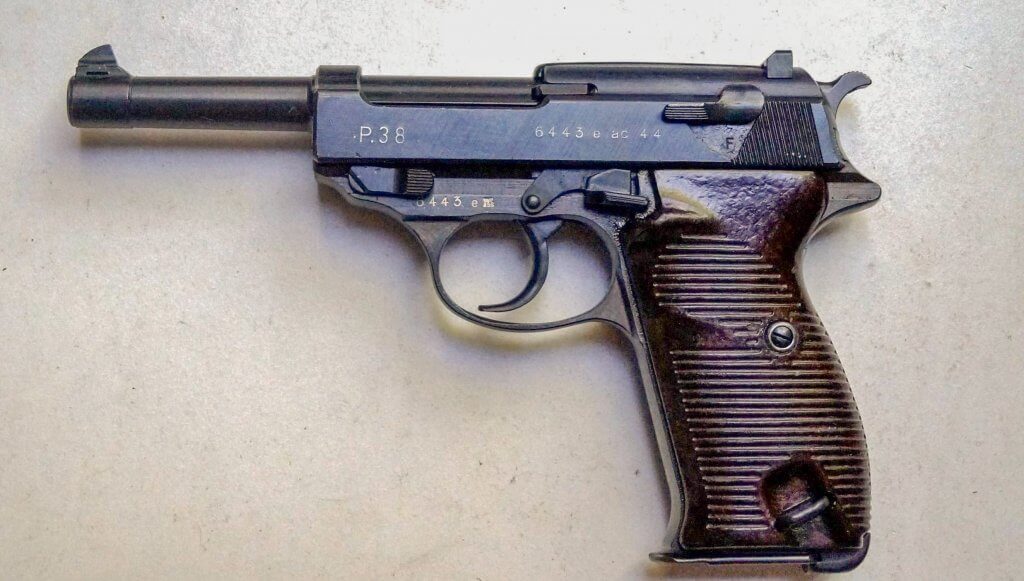
The company continued production during the war. However, they lost basically everything at the end of that conflict due to the factory having been bombed out. In 1953, Carl Walther started over again in Ulm, West Germany where he continued building his P-38 (renamed P-1) for the West German Army, the Bundeswehr.
Fritz Walther died in 1966, so his son Karl-Heinz took over. The company concentrated on the sports sector and started another subsidiary, Umarex. This company concentrated on air guns.
The U.S. Connection
In 1999, Smith and Wesson became the importer for Walther’s guns and even manufactured some for them, if my memory is correct. I remember seeing S&W-made PPK pistols for sale. At any rate, the company formed an American subsidiary to import its guns in 2012.
The new U.S. facility was located in Fort Smith, Arkansas. Since 2018, PPK and PPK/s pistols have been made in that factory.
Enter the Walther PPQ M2
I won’t attempt to describe the history, or backstory, of the 25 pistols Walther is remembered for producing. Let’s just say the company made many different models for law enforcement and civilian use. The PPQ came about in 2011 as a possible replacement for the P99 and shares some of its design features with that popular pistol. One departure, though, is the trigger action.
Described as an “internal preset striker Quick Defense trigger”, the gun is basically always cocked. This gives the gun a let-off point and trigger pull identical from one shot to the next, unlike some striker-fired guns. Also, this gun is marketed in Germany to special-forces-type agencies, (not regular police) due to its different triggers.
Speaking of German police pistols, here is the 2008 specification for triggers on guns considered for adoption by agencies:
The Technical Specifications (TR) of the German Police (Technische Richtlinie Pistolen im Kaliber 9mm x 19, Revision January 2008) for obtaining a German Police duty pistol certification require a first shot trigger pull of greater than or equal to 30 N (6.7 lbf), a trigger travel of greater than or equal to10 mm (0.4 in) and a trigger reset of greater than or equal to 4 mm (0.2 in).
We will look at more design features below. For a fairly detailed look at the PPQ, here is an interesting article — it makes a decent read.
Popular Articles
Walther PPQ M2 Review: Specs and Features
My friend, a deputy sheriff, lent me this rifle to review. As the finish wears, this is his carry. This gun is his “daily carry weapon.” He typically has a light on it, but for this write-up he removed it. Shooting the broken-in gun was exciting.
I am confident in its dependability because of how frequently it is used. The finish wear proves that this is a highly used carry gun (learn more about concealed carry insurance).
Now, let’s check the specs.
| Caliber | 9mm |
| Barrel Length/ Finish | 4.0"; Black Tenifer-Coated; Stainless Steel |
| Sights/ Radius | Fixed; 3-Dot; Low-Profile; Polymer; Phosphorescent Markings; Non-Snag; Rear Adjustable for Windage; 6.1" Radius (factory night sights are available) |
| Weight | 24.5 oz (empty mag) |
| Frame/ Finish | Matte Black Polymer |
| Slide Material | Tenifer Coated |
| Trigger | Striker-Fired Double Action Only; Pre-Cockede |
| Trigger Press | 5.5 lb |
| Trigger Travel | 0.4" Short; 0.1" Reset |
| Magazines Capacity | 15 + 2 |
| Height | 5.3" |
| Width | 1.3" |
| Length | 7.1" |
| Safeties | No External Manual; Trigger Drop Safety; Firing Pin Block; Disconnector Safety; No Mag Safety |
| Grip | Polymer; Non-Slip; Cross-Directional Surface |
| Other | Picatinny Rail; Limited Lifetime Warranty |
By way of comparison, let’s look at a few of the specs for the Gen 5 Glock 19 — arguably the most popular compact 9mm that others are compared with.
| Length: | 7.28" |
| Height: | 5.04" |
| Width: | 1.34" |
| Barrel: | 4.02" |
| Weight (empty mag): | 23.6 oz. |
| Magazine Capacity: | 15, 3 included; higher-capacity mags will work |
I am not trying to prove any points by including these specs. I thought I would just list them for ease of comparison for those of you out there who may be looking to buy a 15-or-greater round 9mm.
Here is a quick list of features that the Walther PPQ M2 enjoys, from the Walther website.
- Ambi and extended slide stop
- Front/ rear slide serrations
- Three interchangeable backstraps (S/M/L)
- Reversible magazine release (M2)
- Large, button-style magazine release (not a paddle release — if you like the paddle-style release, find a 1st gen PPQ, the M1)
- Rear sight adjustable for windage; front sight replaceable
- Enhanced trigger: smooth and clean break; crisp, tactile and audible; short reset
- Rounded with no sharp edges — thin and very concealable
- No trigger press needed to field strip
I especially like that last feature. My reloading bench took one for the team once upon a time when I pulled the trigger on an empty Taurus semi-auto .45 in order to take it down to clean it. Come on, ‘fess up — who out there has done the same thing? Anyway, I really like this gun’s takedown drill.
Popular Articles
Materials and Build
Walther firearms are known for their quality, and the PPQ M2 is no exception. The frame is made from robust polymer, making it lightweight yet sturdy.
The slide and barrel are constructed from Tenifer-coated steel, which is highly resistant to corrosion and wear, ensuring longevity.
Design
The Walther PPQ M2 is a testament to excellent German engineering that combines aesthetic appeal and operational efficiency.
With a sleek look and innovative design, the PPQ M2 sets itself apart from many other handguns in its class. The firearm features a distinctively contoured slide and a smooth barrel that gives it a streamlined look.
Grip and Ergonomics
One of the first things that users notice about the Walther PPQ M2 is its ergonomic design. It features a uniquely sculpted grip with a non-slip, cross-directional surface that fits comfortably in the hand, enhancing the shooter’s control.
This design allows for better hand alignment, reducing fatigue and improving aim during prolonged use.
The grip also features interchangeable backstraps, allowing users to customize the firearm to fit their hand size perfectly, further enhancing control and shooting comfort.
Walther PPQ M2 Review: Photos
Let’s look at some photos before we go shooting.

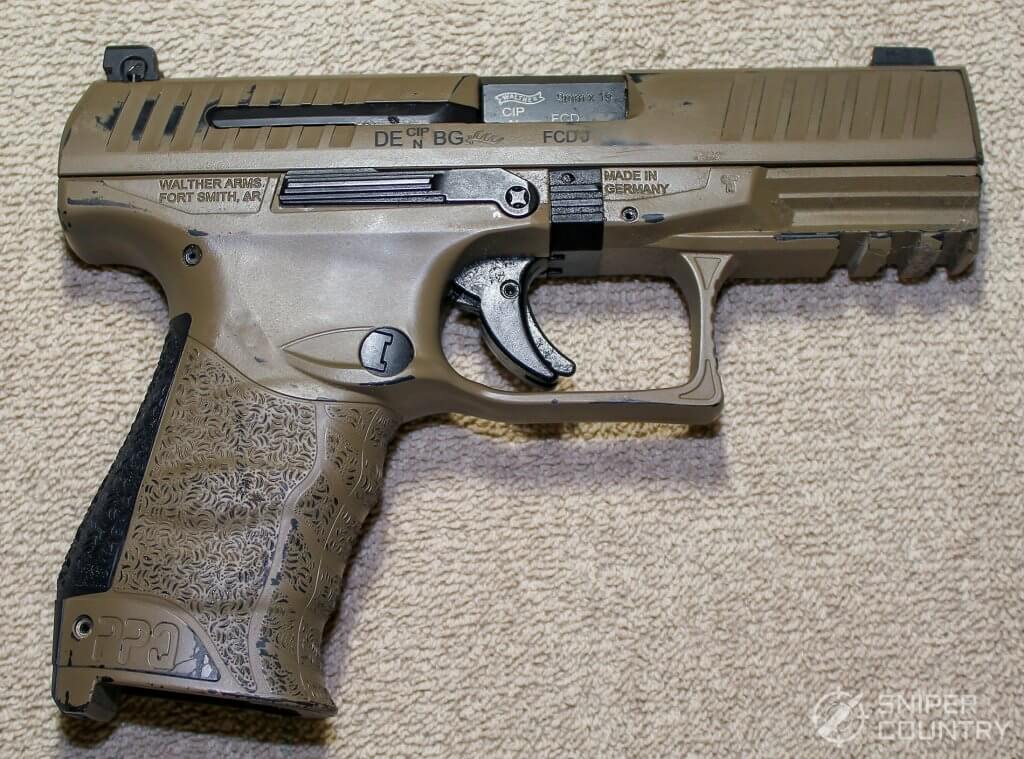
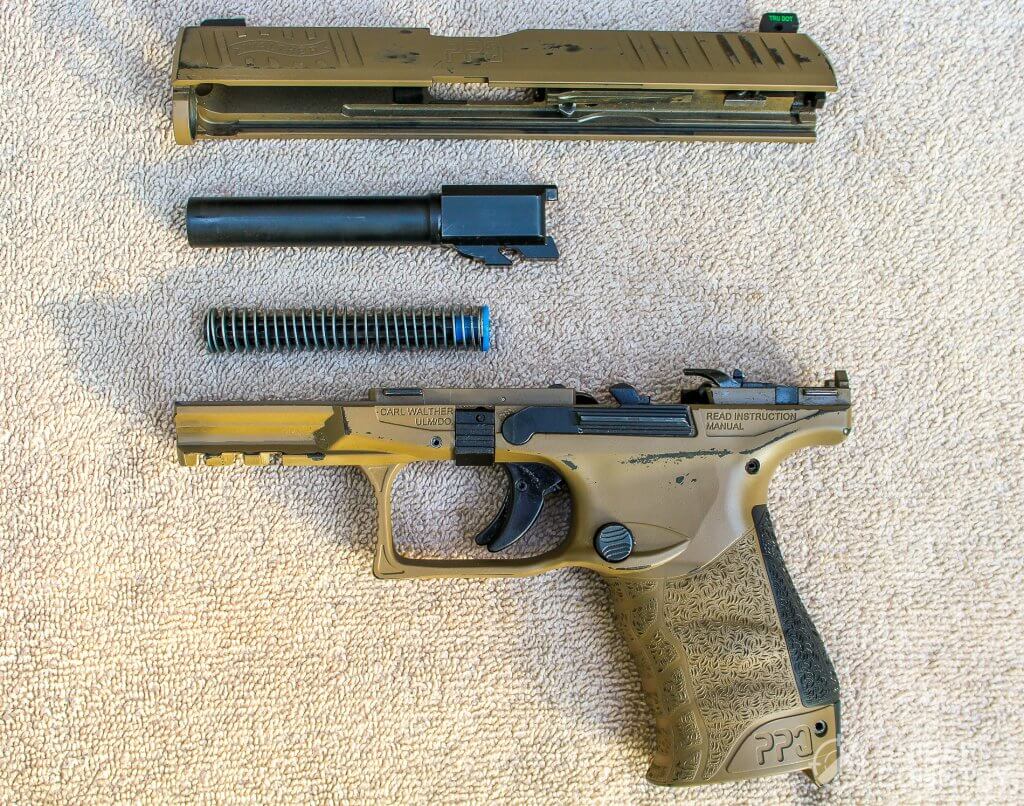
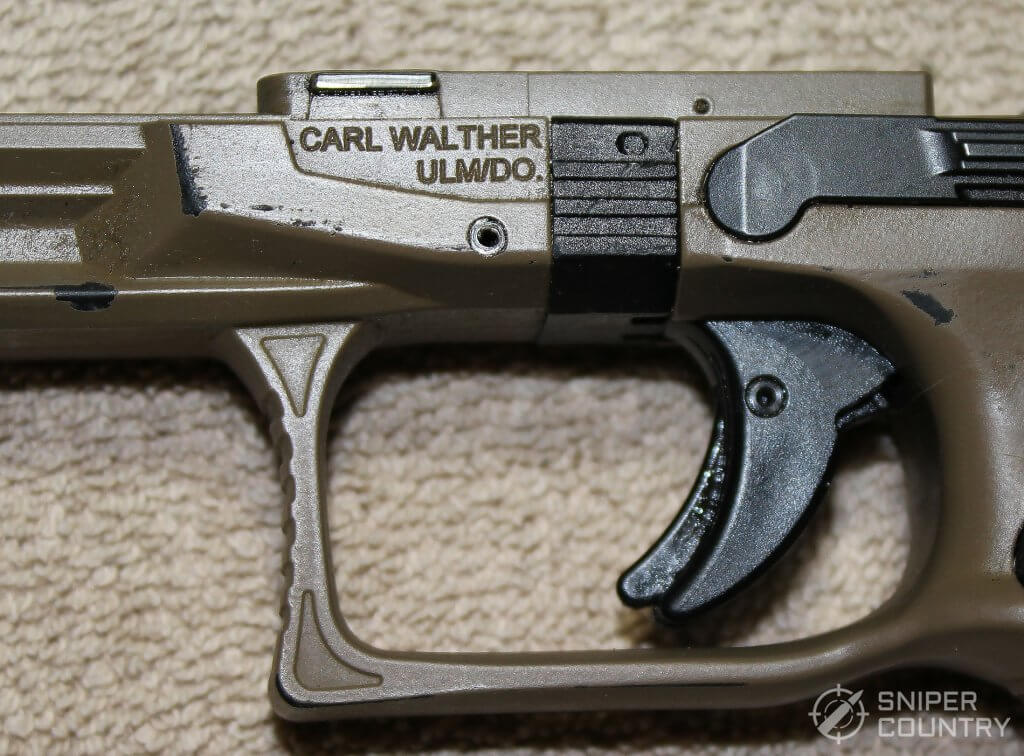

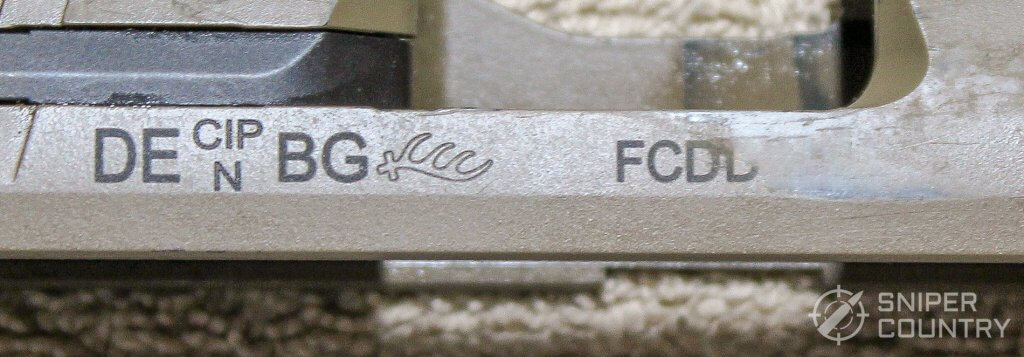
Proof marks: (Here is a good article about proof marks)
- DE = Germany
- CIP/N = Permanent International Commission for the Proof of Small Arms, an international organization similar to our SAAMI that sets standards for safety testing of firearms
- N = Nitro
- BG = date code. B=1, G=6. So, our pistol was made in 2016
- Antler = Ulm, Germany
BONUS OFFER: Get your free shooting range targets to print at home!
Get your free targets to print at home!


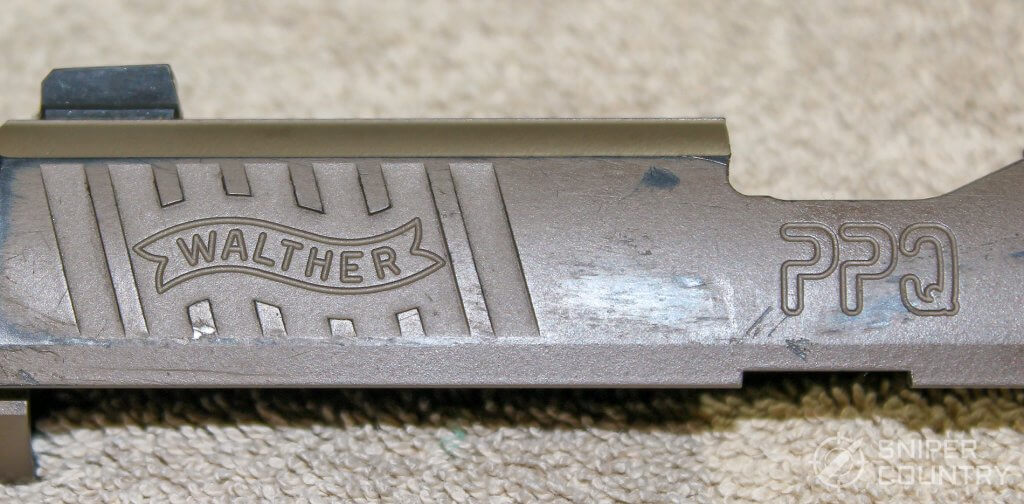

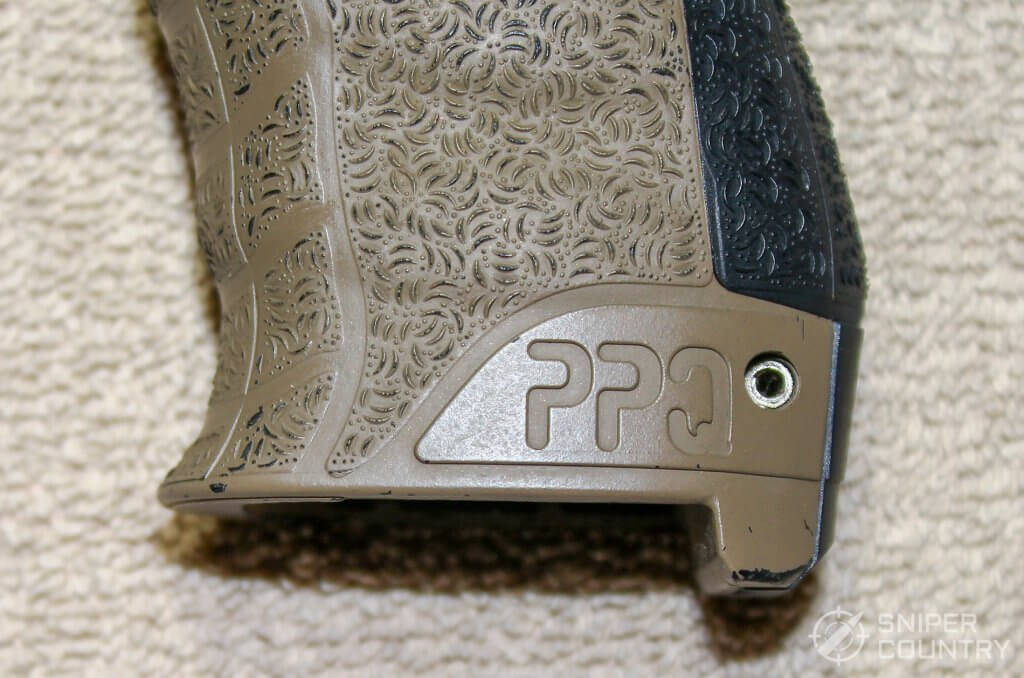


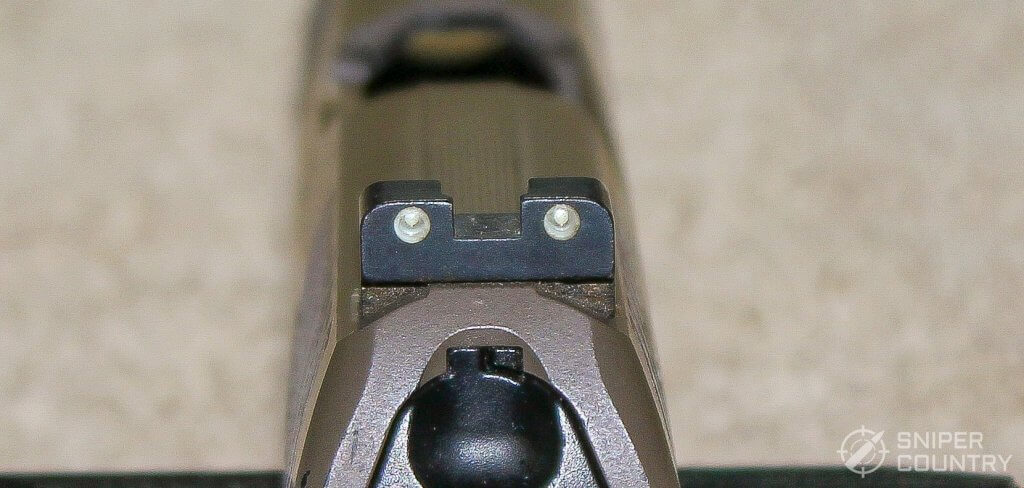
Front sight has a matching dot.


Walther PPQ M2 Review: Taking the PPQ Apart
So, you’ve shot your PPQ and now want to clean it. Very admirable. How hard is it to get the thing into its component pieces for cleaning? Pretty simple, actually. Here are the steps:
- Make sure gun is empty (double-check, trust me) and remove the mag.
- Pull the trigger.
- Retract the slide a half-inch or so and pull down on the takedown tabs directly above the trigger.
- Slide the slide off the front of the frame.
- Separate the barrel and recoil spring.
- Clean everything and put it back together in reverse order.
That’s it. It took longer to type it out than it did to take the thing apart. I was also impressed by the flat-wound recoil spring and the ease with which the gun came apart and went back together.
Speaking of being impressed, here’s something that many Walthers and HKs have that I really appreciate: an ambidextrous slide release that actually works and is not just a right-side extension with little leverage.

Walther PPQ M2 Review: Lefty Considerations
If you look closely, you will notice the right-side slide release’s length. (It’s the same length on the left, as well). This longer lever adds to the leverage applied to the internal release, making it just a bit easier to drop the slide. I have always liked this feature on these guns.
As a lefty, I’ve found that Walthers and HKs are a bit easier to shoot for me due in part to this longer, ambi slide release. They are especially handy for me if they have the trigger guard magazine paddle release.
I know that many, many shooters don’t like that style release, but I sure do. You can get to it with either hand without having to move a button to the other side of the frame. Moreover, there’s nothing wrong with the button-behind-the-trigger-guard unless it’s there permanently and you’re a lefty.

I know, my left-handed brethren will say they just got used to pressing the mag release button with their trigger or second fingers, but why do that if you can get a gun that doesn’t require it? Why break your shooting grip if you don’t have to?
The first generation of this pistol (along with the first gen PPS) used a paddle release. So many shooters objected that Walther re-released them in their respective M2 versions.
Anyway, this is not a rant and there’s no soapbox handy, but it is an issue with me. At any rate, the mag release has zero effect on where the bullets go. Also, putting bullets downrange is the primary function of the gun, not releasing magazines. The paddle is just more convenient for me.
Shooting the Walther PPQ M2
I was really looking forward to shooting this gun. I’d owned a PPQ once, briefly as I mentioned above, and was impressed with it. At the time, I did wonder about the outward angle that the backstrap takes towards the bottom of the grip.
It looks like it sticks out pretty far, which would result in forcing the front sight higher as the hump in the grip pressed into your palm. But, it does not move the sight appreciably. Actually, the gun points naturally for me.
The hump was a non-issue when I owned one before, so I didn’t even think about it when shooting this one. I’m not sure why I traded my PPQ, but sometimes I think I like trading almost as much as shooting.
At any rate, I took this gun to my backyard range and tried three different loads. I almost feel the need to issue a disclaimer about not shooting a lot during any of my recent gun reviews due to the fact that you can’t find 9mm (or several other calibers) ammo anywhere.
I shot a few Winchester white box and Fiocchi loads, both 115-grain FMJ. Also, I shot my favorite 9mm do-all handload of a 124-grain Lee RN cast bullet over 4.8 grains of Long Shot. This load has proven to be accurate in several different 9mm pistols I’ve shot it in, and most always shoots close to the point of aim.
The two factory loads did alright, shot at 20 yards, but the handload was even better. All loads hit a bit low, which made my previous concern about the grip’s hump, causing the gun to shoot high moot.
Again, I feel like I almost have to apologize for not having 6 or 8 targets and a nice, neat Excel table listing loads arranged alphabetically with velocities, standard deviations, etc. but I just don’t have the ammo to do that with right now.
The reloader in me (the OCD part, anyway) would love to be able to do that. Suffice it to say that, in this particular gun’s defense, if it weren’t accurate my friend would not be carrying it. So went the shooting of the PPQ — I wish I had more ammo to put through it, but shooting what I could was fun. It’s a very easy-to-shoot 9mm.
Frequently Asked Questions About the Walther PPQ M2
Does the Walther PPQ M2 have a safety?
The trigger safety mechanism of Walther PPQ M2 handguns consists of a narrow, pivoting lever located in the middle of the face of the trigger, similar to that of other striker-fired, polymer pistols on the market. You can’t pull the trigger until the safety lever is all the way into the trigger slot.
What sights does the Walther PPQ M2 Have?
Both the steel and polymer sights of the Walther PPQ M2 are removable and interchangeable. The rear and front sights are also adjustable. The plastic sight features a screw that allows for click adjustments, with one click shifting the impact point by about .75 inch at 25 yards, while the rear steel sight is drifted left and right to make windage changes.
Also, different height steel and plastic front-sight blades are available for elevation variations. The plastic sights on the gun used the normal three-white-dot arrangement, and the rear notch felt larger than on previous pistols I’d handled.
Can the Walther PPQ M2 handle +P loads?
According to the Walther handbook, the Walther PPQ M2 can take +P loads. However, such loads will accelerate wear and require more regular maintenance. The handbook also states that you should not use +P ammo and you should clean the gun before firing for the first time.
Wrap Up: Is the Walther PPQ M2 a Good Gun?
What did I think overall of the PPQ? As I said above, I owned one for a good while and shot it a lot. Also, I am short and round, so I have trouble concealing full-size (or even some compact) guns. Additionally, the grip tends to print.
My friend who loaned me the gun is tall and thin, so he is a natural for guns like the PPQ, Glock 17, Springfield XD, S&W M&P, etc. His frame tends to hide guns better than mine. Also, he carries the gun in an IWB holster and you can’t tell there’s a gun there until he reaches for it.
So, if you are built in such a way that you can pull off toting a full-size pistol around, you might want to give the PPQ a look. It’s not expensive, and you get a real Walther. With the included two 15-round and an aftermarket 17-round magazine on your person, you’d be ready for just about anything that came your way.
Give the PPQ a try — you might be glad you did. If you own one, or a PPS or other Walther 9mm, let’s hear from you below. As always, keep ’em in the black and stay safe.


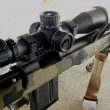







![9mm Glock Models [Ultimate Guide]](https://www.snipercountry.com/wp-content/uploads/2018/10/Glock-17-vs-Glock-19-vs-Glock-26-vs-Glock-41-vs-Glock-43-WM-400x250.jpg)
![Handgun Calibers [Ultimate Guide]](https://www.snipercountry.com/wp-content/uploads/2018/10/Handgun-Caliber-Comparison-400x250.jpg)
![Rifle Calibers [Ultimate Guide]](https://www.snipercountry.com/wp-content/uploads/2018/12/Header-1900-400x250.jpg)

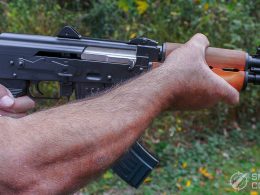
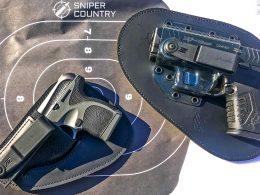
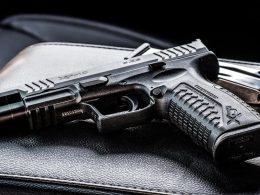
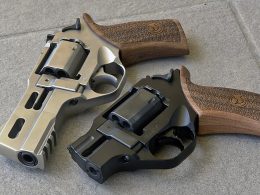

Never having had an experience with Walther nor Glock, my opinion is too many products continue on the market resting on past laurels.
S &W is a classic example, my first handgun was the 44 J frame which had a cylinder release issue.
S&W CS (Oxy moronAHAHA) said it was fine but replaced the yoke.
Why and what for I asked did you do to the yoke?
We don’t keep those records was the response.
Can I speak with the tech..No was the response, next day on a forum one customer relates his experience talking to the S & W tech that worked on his gun.
Lies abound, they must be demorats. My first and last S&W product which includes that useless crimson sight laser product.
My first AR had a pin issue, Ruger took it in and replaced the whole upper and explained why.
Where would I buy my next three guns??? Duh
Reliance upon S&W is not in my opinion a good attitude when one’s life and family’s well being is at stake.
Alan, too bad you had such a bad experience with S&W. I’ve only used their CS once and it went well. Ruger does have top-notch CS in my opinion. Thanks for writing!
Great write up!
The Ppq m2 4” was my first pistol. Owned it for 5 years now. I love it. Can’t even bring myself to upgrade the sights on it. It’s just perfect. I added a light since it’s a safe stored bed side companion. I do carry that periodically IWB in a kydex rig with only 1 quick attack 1.5” wide clip. I highly recommend against that for all day carry. You’re going to want a holster that spreads it out with J hooks. Personally I wouldn’t carry this AIWB, although it is comfortable. I understand the mechanics of the Q it’s a mental hurdle for me there. I would only ever carry a DAO AIWB. Everywhere else I feel 100% comfortable. I’ve ran over 1,500 rounds through it. No issues other than a stove pipe due to my own fault. It’s ran everything I’ve put in it. Aluminum, brass, steel without issue. Fun fact the pro mag Taurus 15rd magazines for the G2c, g2, g3, g3c will work in this fun as well so long as you don’t mind 5 minutes of dremel work. I’ve ran 100’s of rounds through them and haven’t had issues. Fun aftermarket add ons are a micro roni shell made by IWI defense that is a non NFA item pistol brace shell. Jarvis custom makes barrels for them, you can upgrade to the steel frame from Walther and also buy the navy conversion, the Q5 match conversion, and a bunch of other items. The Q is a dream to shoot and my wife shoots it well too. The small back strap doesn’t have the bump problem. Only the med and large. Highly recommended 10/10
Dom, glad you like your Q. I enjoyed the one I had – it was a good shooter. I reviewed a Micro-Roni shell earlier – that was one useful piece of equipment. Thanks for your comments! (I would be interested to know how you modify Taurus mags to work in your gun)…
Mike,
Hope all is well. Meant to respond sooner. Anyway the G2C magazines are mecgar mags, same as the ppq. Which led me to wonder if they’re compatible. The dimensions are close enough. I use the promag 15Rd and promag 32 rd pt111 g2 mags in my ppq m2. All you need to do is lightly dremel out the mag catch hole about 1/8” down, shave a small amount off of the rear of the feed lip on the extractor side and slightly bevel the edges around the top of the mag with a hand file and boom you’re good to go. Sorry I couldn’t be more detailed. I did a shotty write up on walther forums with pictures, but I haven’t been able to include the link in the comments here. I Wouldn’t say these are as good as the factory mags, but if you happen to find yourself in a situation such as I have with having a G2c and a ppq then it’s a fun experiment. Also the 12round G2c mags will work in the ppq as well if you remove the polymer floor plate as the G2c mags have an internal floor plate.
Dominic, that’s good to know. Any time you can use a mag made for one gun in another, that’s a win. Thanks for your instructions, and thanks again for writing.
I’ve been the proud owner of a PPQ M2 in .40 S&W since 2012, and I’ve nothing but praise for it. First gun I’ve ever been consistent with my double taps. I carry it during the cool/cold months. Having just enough of a belly to make it hard to carry concealed in the warm months. I’ve been a Walther fan for over 35 years, my first CC weapon was a a PPK/S. Only retired it because the sights were difficult for aging eyes in low light.
Bemused (interesting handle, for sure), I haven’t shot one in .40 but I’ll bet it works just fine. And, I know about the belly issue… You carried a PPK/S? I’m assuming in .380. I have always wanted to own one of those – maybe some day. Thanks for writing – I appreciate your comments!
Have a PPS in 9mm, love the feel, very concealable. Only issues I’ve had were that I had a surprisingly hard time finding holsters that I liked for it, and just the fact that I haven’t been able to put enough rounds through it to feel comfortable making it an EDC yet.
Steve, the PPS is one popular Walter, for sure. I had one – it concealed well and fired every time it needed to. Keep looking – there are holsters out there and hopefully you’ll find one soon that you like. Thanks for writing!